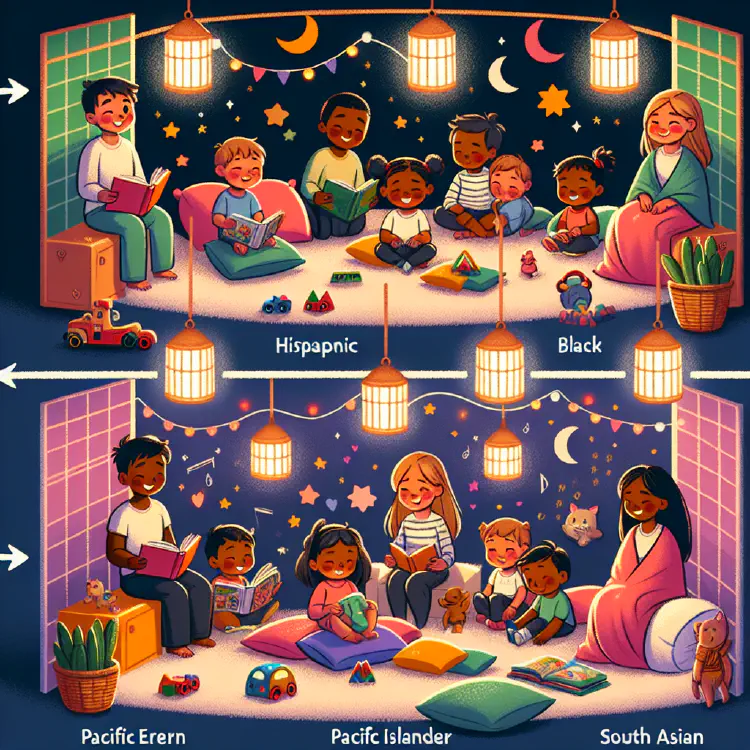How to Transition from Playtime to Storytime Smoothly
Effective strategies for transitioning from playtime to storytime include setting expectations, creating rituals, gradually winding down, and involving children in story selection.
- 4 min read

As parents, we all know the importance of a consistent bedtime routine for our little ones. It helps them wind down, relax, and prepare for a good night’s sleep. One of the most cherished parts of this routine is often storytime, where we share bedtime stories with our children. However, getting from the excitement of playtime to the calm of storytime can sometimes be a challenge. In this blog post, we’ll explore effective strategies to make this transition smooth and enjoyable for both you and your child.
The Importance of a Smooth Transition
Before we dive into the strategies, let’s understand why a smooth transition from playtime to storytime is so crucial. Children thrive on routine and predictability. A sudden shift from high-energy play to quiet reading time can be jarring for them, potentially leading to resistance or difficulty settling down. By creating a gradual transition, we help our children’s minds and bodies prepare for the calming experience of bedtime stories.
- Set Clear Expectations
One of the most effective ways to ensure a smooth transition is to set clear expectations from the start. Let your child know in advance that playtime will be followed by storytime. You might say something like, “We’ll play for 20 more minutes, and then it’s time for our bedtime story.” This gives your child time to mentally prepare for the change in activity.
For younger children, especially toddlers, you might need to repeat this reminder a few times during playtime. Visual cues, like a timer or a special clock, can also help them understand when storytime is approaching.
- Create a Transition Ritual
Developing a short ritual to signal the shift from playtime to storytime can be incredibly helpful. This ritual acts as a bridge between the two activities, helping your child’s mind and body start to calm down. Here are some ideas for transition rituals:
- Sing a special song that signals it’s time to clean up toys and prepare for bed
- Do a quick tidy-up of the play area together
- Have a brief stretching or yoga session
- Take a few deep breaths together
- Light a special “storytime” candle (LED candles are great for this)
The key is consistency. Whatever ritual you choose, try to do it every night so it becomes a familiar and comforting part of the routine.
- Gradually Wind Down the Energy
Instead of abruptly ending playtime, try to gradually decrease the energy level of the activities. If your child has been running around, transition to a quieter seated game. If they’ve been playing with noisy toys, switch to something calmer like coloring or puzzles. This step-down approach helps your child’s body and mind begin to relax, making them more receptive to the calm atmosphere of storytime.
- Create a Cozy Reading Nook
Having a dedicated space for reading bedtime stories can make the transition more appealing. Set up a cozy corner with soft pillows, blankets, and maybe even a special reading lamp. This space should be different from where playtime happens, helping to create a mental shift for your child.
When it’s time for storytime, you can say, “Let’s go to our special reading spot!” This can build excitement for the upcoming activity while still maintaining a calm atmosphere.
- Let Your Child Choose the Story
Involving your child in the selection of bedtime stories can increase their enthusiasm for storytime. You might want to limit the choices to two or three books to prevent decision fatigue, but allowing them to have a say can make them feel more invested in the activity.
For older children, you could even make this part of the transition ritual. As you’re winding down playtime, you could say, “It’s almost time for our bedtime story. Why don’t you go pick out the book you’d like us to read tonight?”
- Use Transition Objects
Transition objects can be powerful tools, especially for younger children. This could be a special stuffed animal that only comes out at storytime, or a cozy blanket used specifically for reading. These objects serve as physical reminders that it’s time to calm down and prepare for bed.
You might say, “Let’s go find Mr. Snuggles. He’s waiting to hear our bedtime story!” This can help shift your child’s focus from playtime to the upcoming storytime activity.
- Incorporate Calming Sensory Elements
Engaging multiple senses can help create a calming atmosphere conducive to storytime. Consider these ideas:
